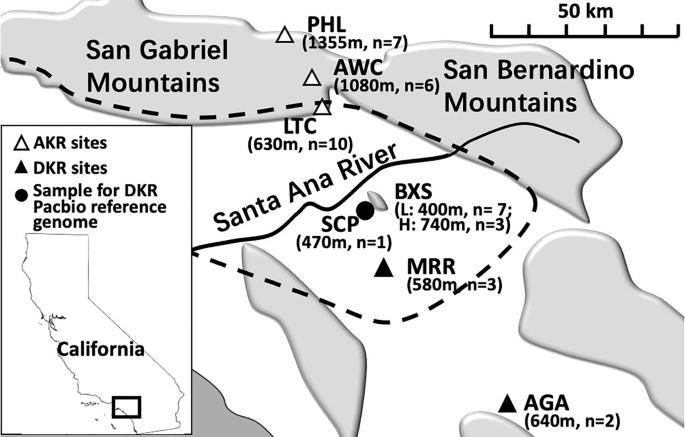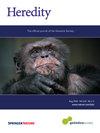原同源的敏捷(Dipodomys agilis)和Dulzura (D. simulans)袋鼠大鼠的分化和人口统计学的基因组分析。
IF 3.9
2区 生物学
Q2 ECOLOGY
引用次数: 0
摘要
太平洋袋鼠鼠(Dipodomys agilis)的核型变异促使其于1997年在其加利福尼亚活动范围的北部分裂为敏捷袋鼠鼠(AKR, D. agilis, 2N = 62),在其南部分裂为Dulzura袋鼠鼠(DKR, D. simulans, 2N = 60),在圣加布里埃尔山脉和圣贝纳迪诺山脉以南疑似同属区。我们的全基因组测序支持了这一划分,我们对从山区北部到河滨县西南部约120公里的样带进行了采样。该分类群表现出明显的遗传分化,没有杂交或同属的证据。AKR出现在山脉的南部边缘,排除了山脉屏障导致的隔离,表明山脉与南部干旱地区之间的栖息地差异与生态分离有关。再加上另外四个双足属物种,我们估计该属的遗传分化时间可追溯到3.5亿年前。当AKR和DKR的联合有效种群大小(Ne)为~100,000时,它们与斯蒂芬氏笛虫的分化时间为~ 1.7万年,彼此分化时间为~ 0.5万年。分离后,DKR的Ne下降到~ 20000,而AKR的Ne变化不大。最近,它们的Ne收敛到~50,000。AKR的纯合序列较长,表明其邻域较小,这可能促进了核型的变化;然而,AKR的核苷酸多样性更高,但两者都具有啮齿类动物的典型水平,表明两者都没有经历最近的瓶颈。这些模式为未来的保护工作提供了一个基准。更一般地说,这项研究显示了详细的基因组研究如何解决形态上难以区分的分类群之间的分类学和人口学问题。本文章由计算机程序翻译,如有差异,请以英文原文为准。

Genomic analysis of differentiation and demography of the formerly conspecific agile (Dipodomys agilis) and Dulzura (D. simulans) kangaroo rats
Karyotype variation within Pacific kangaroo rat Dipodomys agilis motivated its division in 1997 into the agile kangaroo rat (AKR, D. agilis, 2N = 62) in the north of its range in California, and Dulzura kangaroo rat (DKR, D. simulans, 2N = 60) to the south, with a suspected sympatric zone south of the San Gabriel and San Bernardino Mountains. This division was supported by our whole genome sequencing that sampled a ~120 km transect from north of the mountains to SW Riverside County. The taxa showed marked genetic differentiation, with no evidence of hybridization or sympatry. AKR was found at the southern edge of the mountains, precluding the mountain barrier driving isolation, suggesting ecological separation linked to habitat differences between the mountains and the arid area to the south. Adding four additional Dipodomys species, we estimated genetic divergence times in the genus back to ∼3.5 mya. AKR and DKR diverged from D. stephensi ∼1.7 mya, and from each other ∼0.5 mya, when their joint effective population size (Ne) was ~100,000. After separation, DKR’s Ne declined to ~20,000, while AKR’s was little changed. More recently their Ne converged at ~50,000. Runs of homozygosity were longer in AKR, indicating a smaller neighborhood size, which may have promoted the karyotype change; however, nucleotide diversity was higher in AKR, but both had levels typical for rodents, indicating neither experienced recent bottlenecks. These patterns provide a baseline for any future conservation efforts. More generally, this study shows how a detailed genomic study can resolve taxonomic and demographic questions among morphologically indistinguishable taxa.
求助全文
通过发布文献求助,成功后即可免费获取论文全文。
去求助
来源期刊

Heredity
生物-进化生物学
CiteScore
7.50
自引率
2.60%
发文量
84
审稿时长
4-8 weeks
期刊介绍:
Heredity is the official journal of the Genetics Society. It covers a broad range of topics within the field of genetics and therefore papers must address conceptual or applied issues of interest to the journal''s wide readership
 求助内容:
求助内容: 应助结果提醒方式:
应助结果提醒方式:


